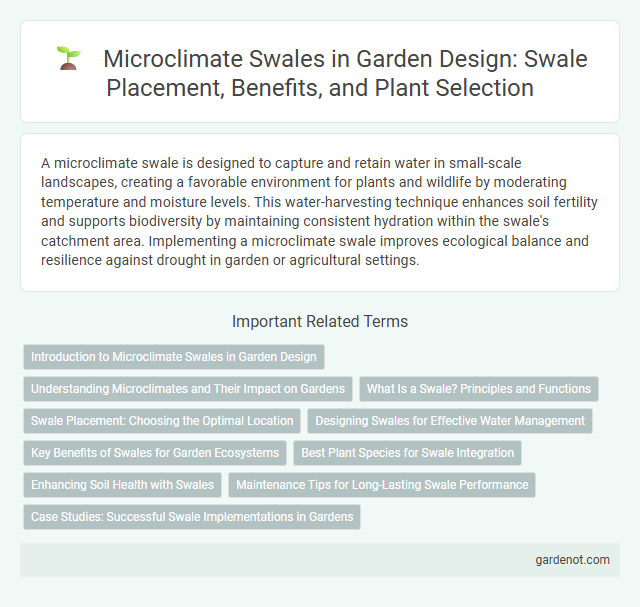A microclimate swale is designed to capture and retain water in small-scale landscapes, creating a favorable environment for plants and wildlife by moderating temperature and moisture levels. This water-harvesting technique enhances soil fertility and supports biodiversity by maintaining consistent hydration within the swale's catchment area. Implementing a microclimate swale improves ecological balance and resilience against drought in garden or agricultural settings.
Introduction to Microclimate Swales in Garden Design
Microclimate swales are landscape features designed to improve water retention and create localized microenvironments in garden design. By contouring the land to capture rainfall and slow water runoff, these swales enhance soil moisture levels, promoting healthier plant growth and mitigating drought stress. Integrating microclimate swales supports biodiversity by providing varied habitats and microhabitats that benefit a wide range of garden flora and fauna.
Understanding Microclimates and Their Impact on Gardens
Microclimate swales create localized environmental conditions by capturing and directing water flow, significantly influencing soil moisture and temperature in gardens. These features enhance plant growth by moderating extreme weather effects, reducing evaporation, and promoting biodiversity. Understanding microclimates within swales helps gardeners optimize plant selection and placement for improved yield and ecosystem resilience.
What Is a Swale? Principles and Functions
A swale is a shallow, vegetated channel designed to manage water runoff, promote infiltration, and prevent erosion. Key principles include guiding stormwater away from impervious surfaces, enhancing soil moisture retention, and supporting native plant growth to improve biodiversity. Swales function as sustainable drainage systems that reduce flooding risk, filter pollutants, and recharge groundwater.
Swale Placement: Choosing the Optimal Location
Swale placement is critical for maximizing water capture and improving microclimates by directing runoff to areas where it benefits vegetation most effectively. Optimal locations are typically on contours or gentle slopes, where swales can slow water flow, promote infiltration, and reduce erosion. Positioning swales near plant root zones enhances soil moisture retention, supporting diverse and resilient plant communities.
Designing Swales for Effective Water Management
Designing swales for effective water management involves strategically shaping and grading the land to maximize water infiltration and reduce runoff. Incorporating vegetation with deep root systems enhances soil stability and promotes natural filtration of pollutants, improving the microclimate by maintaining moisture levels and reducing temperature fluctuations. Properly designed swales support groundwater recharge and mitigate erosion, contributing to sustainable urban and agricultural landscapes.
Key Benefits of Swales for Garden Ecosystems
Swales significantly enhance garden ecosystems by improving water infiltration and reducing soil erosion, which promotes healthier plant growth and biodiversity. They create microclimates that regulate temperature and moisture levels, supporting diverse flora and beneficial insects. By managing runoff and increasing soil organic matter, swales contribute to more resilient and sustainable garden environments.
Best Plant Species for Swale Integration
The best plant species for swale integration include native grasses like Deschampsia cespitosa and Carex species, which enhance soil stabilization and water absorption. Deep-rooted plants such as Juncus effusus improve filtration and support microclimate regulation by maintaining moisture levels. Incorporating diverse perennials like Echinacea purpurea and Asclepias tuberosa promotes biodiversity and resilience within swale ecosystems.
Enhancing Soil Health with Swales
Swales improve soil health by promoting water infiltration and reducing erosion, creating a favorable microclimate for plant roots. The increased moisture retention supports microbial activity and nutrient cycling, enhancing soil fertility naturally. By maintaining consistent soil moisture levels, swales help establish resilient vegetation that stabilizes the ecosystem.
Maintenance Tips for Long-Lasting Swale Performance
Regular inspection and clearing of debris from a microclimate swale prevent blockages and ensure optimal water infiltration. Maintaining vegetation by trimming invasive plants and promoting native species enhances soil stability and improves moisture retention. Periodic soil testing helps identify erosion or compaction issues early, supporting timely corrective measures for sustained swale efficiency.
Case Studies: Successful Swale Implementations in Gardens
Microclimate swales have been effectively implemented in various garden projects, showcasing improved soil moisture retention and enhanced plant growth in arid regions. Case studies like the urban garden in Melbourne and the community green space in Tucson demonstrate how these swales mitigate heat stress and support local biodiversity. Data from these projects reveal a 30% increase in soil water availability and a noticeable drop in surrounding ambient temperatures.
Microclimate swale Infographic

 gardenot.com
gardenot.com